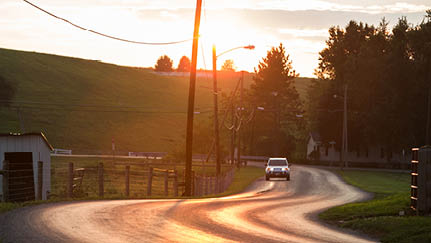2021 traffic safety facts1
- 42,939 motor vehicle traffic fatalities: 17,103 (40%) in rural areas, 25,598 (60%) in urban areas and 238 (1%) in unspecified areas
- 20% of U.S. population lived in rural areas but accounted for 32% of total vehicle miles traveled (VMT) and 40% of traffic fatalities
- Fatality rate per 100 million VMT was 1.5 times higher in rural areas than in urban areas
For Nationwide, the number one farm insurer in the U.S.2, rural road safety is a particular concern. That’s why we surveyed 1,800 consumer and commercial drivers on what they observe and the hazards the landscape and driver behavior pose when traveling on rural roads.
“We conducted the survey to better understand the challenges impacting our customers and agents, and learn how we can better support them,” said Nationwide Senior Associate Vice President for Agribusiness Risk Management Laramie Sandquist.
The survey revealed, in fact, that rural roads pose unique and often underestimated dangers for drivers, and in many respects, they can be more hazardous than urban roads. Whether you're a co-op driver delivering grain, a farmer transporting livestock, or a rural resident commuting to town, it’s crucial to know and respect the risks associated with rural driving.
Why are rural roads more dangerous?
The Federal Highway Administration attributes the higher fatality rate on rural roads to various factors, including:
- Physical characteristics of rural roadways. Rural roads often have tighter curves, limited visibility, less lighting and lack shoulders and clear zones, which are crucial for vehicle recovery when they veer off.
- Behavioral issues. Drivers on rural roads tend to exceed the speed limit, fail to use their seat belts and drive impaired.
- Longer emergency response times. Crashes on rural roads carry a high risk of severe injury and fatalities due to longer travel distances for emergency responders and greater distances to trauma centers.
"While there are many causes of rural road accidents, staying distraction-free is key," Sandquist said. "Our survey finds one-third of commercial drivers admit they sometimes or often feel distracted behind the wheel. That’s why we created the Drive the 5 safety program to help transform driving behavior."
Plan ahead and minimize distractions on rural roads
If you’re new to a rural area, plan your route ahead of time. That way, you can know what to expect on the road. Even if you do plan ahead, staying alert is the best way to prevent accidents on the road. The use of cell phones and other electronic distractions such as GPS navigation systems, work-related texts and social media activity are major causes of driver distraction. They’re big reasons why Nationwide advocates for hands-free legislation and distracted driving laws around the country.
”Driver error, distracted driving and fatigue are among the leading causes for accidents on rural roads. That’s why knowing the hazards of the environment around you, causes of distracted driving, and how to avoid them is so important to us at Nationwide,” Sandquist said.
Get resources to stay safe on the road
Geared for drivers in the agriculture, food and fuel sectors, Nationwide's Drive the 5 program guides drivers through five key principles of road safety and offers essential safety training to help improve driver behavior.
